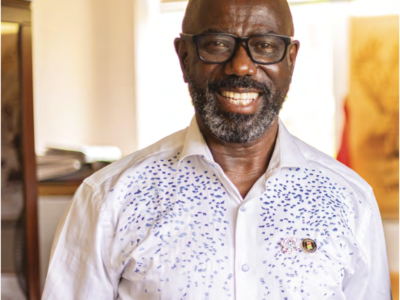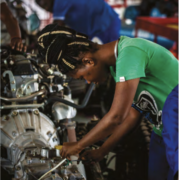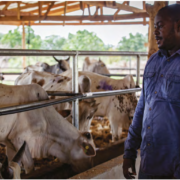How does the Ghana Export Promotion Authority work?
The Ghana Export Promotion Authority (GEPA) is the National Export Trade Support Institution of the Ministry of Trade and Industry (MOTI), responsible for the facilitation, development and promotion of Ghanaian exports.
Our focus has primarily been to diversify Ghana’s export base from the traditional gold and other unprocessed minerals, cocoa beans, timber logs and lumber.
GEPA’s clientele includes over 3000 registered private sector exporting companies, organised into approximately 17 Export Product Associations. GEPA relates to these clients both on an individual and corporate basis and as groups / associations. GEPA also acts as an interface between these exporters and other public organisations.
GEPA facilitates trade by:
- Identifying and registering exporters
- Developing exporters through the GEPA export school where they are trained on the rudiments of export business and standardisation of products
- Ensuring exporters’ products are export-ready by building their capacity to meet standards required on international markets. For instance, GEPA recently collaborated with the International Trade Centre (ITC) to educate Women Owned Businesses on the importance of good shea packaging
- Providing relevant market information to exporters and leading them to explore markets abroad.
GEPA’s main mission is to diversify the export base from the traditional gold, crude oil and cocoa beans. One of President Akufo-Addo’s mottos is that “We cannot, and should not, continue to be merely exporters of raw materials to other countries.” The government has created a state-owned company to help establish an integrated aluminium industry and is planning to set up another company for the iron and steel industry. Can you tell us about your efforts to increase exports of processed and semi-processed goods?
In pursuit of our mandate to develop and promote non-traditional exports and essentially diversify our export base as a country, we have focused attention on supporting Ghanaian companies to add value to agricultural raw materials and on manufacturing sectors such as garments, aluminium and plastics. Th ese sectors are currently doing well. Indeed, the Ghanaian aluminium and plastic sectors are dominant as far as our exports to the ECOWAS market are concerned, thanks to the pioneering work done by GEPA and the Association of Ghana Industries in opening the regional market to Ghanaian exporters.
We also use various platforms that provide opportunities for capacity building of exporters, to empower them and enable them to meet the requirements of international markets – a good example being the hosting by GEPA of the International Trade Centre (ITC) Trade For Sustainable Development (T4SD) Hub in Ghana. The T4SD Hub supports export-oriented SMEs to build their capacity to use their production resources efficiently and sustainably within the circular production environment to build green sustainable businesses.
Another key area of GEPA’s support to export-ready companies is the facilitation of their participation in international fairs and exhibitions. In 2019 alone, we have supported about one hundred and fifty exporters to attend 15 different fairs in Europe, Africa and the US. Th e majority of these fairs have been retail and sourcing fairs for semi-processed and processed products. The results so far have been quite good, both in terms of the international exposure for the companies and the significant orders that have been received.
OUR FOCUS HAS PRIMARILY BEEN TO DIVERSIFY GHANA’S EXPORT BASE FROM THE TRADITIONAL GOLD AND OTHER UNPROCESSED MINERALS, COCOA BEANS, TIMBER LOGS AND LUMBER.
In 2017 GEPA supported cashew farmers and in 2018 cashew exports grew 43.84%, leading the growth of Non-Traditional Exports. What activities did you choose to support in 2018/19 and what do you expect in terms of exports?
We are building on the successes achieved through our timely interventions in the cashew sector. Indeed, we are being guided by the ten-year cashew development plan that was launched in 2017 by His Excellency the President. We are working towards achieving the cashew production and ex-port revenue targets in the plan, and I must say we are on course to achieving them.
Another area of intervention which has engaged our attention since 2017, and which we are continuing, is the pineapple supply capacity improvement project. With this, we are making available to medium-sized pineapple producers and processors and their out-growers, significant quantities of suckers for planting.
The objective is to ensure that pineapple production reaches once again the 70,000 tonnes we were noted for in the 1990s and early 2000s. Due to a combination of factors, production of the crop declined over the years to as low as 30,000 tonnes and export revenues fell to below US$10million. Although this situation is regrettable, we are determined to reverse it in the next few years. In this regard, in the last two years alone, GEPA was able to procure and distribute to farmers more than 17 million suckers of the three main pineapple varieties, i.e. MD2, Smooth Cayenne and Sugarloaf. We are confident that export revenues from fresh and processed pineapples will once again rise in the next few years.
In which sectors would you like to see more foreign investment to help boost exports and what incentives can you offer?
From our 2018 performance report on Non-Traditional Exports, Semi-Processed and Processed Goods contributed 78.53%. We do know from analysis that the area of value addition attracts higher foreign exchange and it requires significan’t funding to process agricultural produce and industrial arts and craft s.
In the last year, agricultural produce and handicraft s grew by 34.04% and 23.65% respectively – an indication that with an investment boost in these sectors, that base could record a remarkable increase.
In last year’s Top Guide, you mentioned plans to promote public-private partnership investments in warehouse facilities to make the distribution of made-in-Ghana products easier. How is this project progressing?
These projects are long-term in nature. However, we have made some progress since last year. I am happy to say that we have identified some very good warehouse facilities in some targeted markets and are working hard to complete the required processes for their legal acquisition. Of course, we need to follow the right procedures to ensure that we kick off right as this involves huge funding commitments.
We are hopeful that the significant aspects of the acquisitions will be completed by the end of the year so that we can start full implementation from 2020.














Comments